The concept of jewellery is almost as old as human history, and has evolved along with humanity. Used for various purposes like adornment, display of rank, wealth, status, or even as a token of trade, jewellery has been ever-present in human society. It serves the same broad range of purposes even today. It can mean so many different things to different people: a reminder of family history, a memento marking a special life event, a trendy accessory, or simply a sound investment.
The boom in online shopping over the past decade, and in particular the democratisation of online selling through platforms like Shopify, has resulted in an increasing number of shoppers flocking to online jewellery stores. Indeed, the global online jewellery market is expected to grow by nearly USD 20 billion (INR 1.5 lakh crore) between 2020 and 2024. Thus, if you’re interested in starting an online jewellery business, it looks like right now is a great time to do so.
We’ve prepared this guide to help you get an overview of the opportunities in this market, and to discuss the practical steps involved in starting an online jewellery store so that you can hit the ground running.
1. Jewellery and India
In today’s India, as befits the country’s diversity, you can find jewellery of all sorts, ranging from trinkets to expensive and exquisite masterpieces, and from glamour pieces to religious symbols. The materials used are just as varied and include everything from coated alloys to 24-carat gold and platinum. There is a niche for everyone who wishes to indulge. We cannot underestimate the ubiquity and impact of jewellery among the people here. Jewellery may be a fashion statement for some, while it may be something deeply personal and meaningful for others.
Today, we are seeing a rise in the sales of well-made but relatively inexpensive jewellery pieces, which serve as fashion statements and are mass-produced. Traditional jewellery, made from precious metals and gemstones, is considered to be more of an investment or heirloom, and is usually only worn during religious gatherings or special occasions.
The bottom line is, jewellery is a major part of the Indian market and will continue to be so for the foreseeable future.
2. Why is selling jewellery online a good idea?
The newest trend in the jewellery market is the online sale of jewellery without an associated physical store and all the expenses and overheads the latter entails. The growth of high-speed internet and technical know-how in urban India, along with the Covid-19 pandemic, has greatly helped push the concept of online shopping forward, and jewellery shopping is no exception to that trend. Indeed, facilities like free returns, which are common in the ecommerce world, can ease the traditional customer into going beyond the need to touch, feel, and try out jewellery before making a purchase.
Online shopping has provided a new pool of customers for jewellery sales. Even brick-and-mortar jewellery stores are now setting up online stores and selling their goods on social media; hobbyists are turning their passion for jewellery-making into a business by selling their products online; even wholesalers and dropshippers are enjoying the benefits that digital sales provide.
Unlike a traditional store which requires a lot of capital, employees, and physical floor space, there are no prerequisites to starting your own online jewellery store other than some basic technical knowledge and a source for your products.
Given the increasing consumer interest, the relative ease of setting up an online store, and the relatively modest capital required to get started, it is clear that selling jewellery online is indeed an excellent idea.
In the rest of this blog post, we’ll be talking about several key aspects of selling jewellery online: the various business models, how to set up your own online store, acquiring and retaining customers, and much more.
3. Business models for selling jewellery online
There is a huge gap between the perceived value of jewellery and the actual value of the raw materials and effort used to make it. The production costs are greatly outstripped by the market prices of jewellery, traditionally speaking. This is so because jewellery has emotional resonance and symbolism which, to put it simply, goes beyond mere utility. In commercial terms, jewellery can be considered a high-margin business, which is great news if you’re looking to get into it.
To start selling jewellery online, the very first thing you need to do is choose a suitable business model.
There are three broad categories of business models that can be used to sell jewellery online:
-
Augmenting your existing jewellery store by also having a presence online
With this model, you already have your goods ready to be sold, and the only part that remains is setting up your online store. Thankfully, taking your brick-and-mortar store online has never been easier.
-
Making your own jewellery and selling it online
Whether you are a hobbyist or a professional jewellery maker, you can expand your clientele and showcase your products to a wider audience by creating an online jewellery business.
-
Sourcing jewellery from third parties and selling it online
To successfully create an online jewellery store, you do not necessarily need to be able to make jewellery. For instance, you could design your products and have them manufactured, comb through available products and curate your own collection for sale, or even get customised pieces made individually from manufacturers. Moreover, by dropshipping or re-selling products, you can create your own place in the online ecosystem without having to participate in the production side of things. Such a business model is low-investment and can be successfully implemented with some careful management of logistics. Another related option is private labelling, which involves buying products from third-party manufacturers, branding them with your own label, and selling them on your online platform.
4. Where can you sell jewellery online?
There are many online platforms where you can sell jewellery. These platforms can be grouped into three main categories:
-
Social media
There is no doubting the reach and engagement of social media in today’s connected world. Influencers have made it clear just how powerful social media can be. With careful planning and execution, you can use social media as a platform to sell jewellery online. You can set up an Instagram or Facebook store and start selling your jewellery products in a jiffy.
-
Ecommerce marketplaces
Alternatively, you can use existing online marketplaces like Amazon and Flipkart to sell your jewellery relatively easily. These platforms have the benefit of a huge existing clientele and the highest level of brand recognition. They’ve already done the hard work of getting customers to trust them, and if you are able to register yourself as a seller, you will be able to get started with selling your products online.
Alternatively, Etsy is an online marketplace featuring independent sellers of handmade, vintage and artisanal products. This means a visitor on Etsy is quite likely to already be interested in your kind of product. No surprise that jewellery is among the product categories with the highest number of listings here.
Amazon has a list of requirements that you need to meet to sell your products on their platform, as do Flipkart and Etsy.
Selling on online marketplaces is a bit more complicated than having your own store as it involves seller commissions, compliance with standards, and a minimum stock of inventory. However, if you are able to scale your production or already have a sufficiently scaled production, you will be able to sell jewellery relatively easily on these platforms.
-
Independent online store
A third option is creating your own website and/or online store with your own domain name to sell your jewellery online. This option allows you great freedom to build your own online storefront and greater control over how your potential customer perceives your brand. There is some upfront effort and investment required to build your online store before setting your business in motion. Fortunately, this is made a lot easier by new-age ecommerce store builders like Shopify which come with a whole host of features and plugins to help you run your online business efficiently.
5. Benefits of setting up your own online jewellery store
Compared to selling jewellery on social media platforms and ecommerce marketplaces, building your own online store offers several distinct advantages:
- In addition to selling your products on your online store, you can also integrate your store with social media platforms and ecommerce marketplaces through apps and plug-ins, including integrations with Etsy. This means that you will be able to sell on all three kinds of platforms through your online store.
- You can scale your store as per your requirements, without any restrictions or limitations, and avoid marketplace-related commissions (unlike ecommerce marketplaces).
- You will be able to process orders, manage logistics, and track inventory across all your portals on a single unified dashboard.
- You can manage marketing functions like search engine optimisation, conversion rate optimisation, email marketing, and more through easy-to-use apps and plugins.
- You will have complete autonomy to design the user journeys of your potential customers, and therefore a greater handle on conversions.
- You will have access to the treasure trove of your store’s data, analytics and reports which you can use to gather insights, optimise and improve your business.
6. How to start a jewellery business online?
Building any ecommerce business, whether you are taking an existing business online or starting from scratch, may seem like a daunting challenge. However there are a few resources available to help you break it down into clear actionable steps:
- Ecommerce Business Blueprint: How to Build, Launch, and Grow a Profitable Online Store
- The Essential Shopify Store Launch Checklist — Start a Business
In this section, we shall go through the steps for building a successful online jewellery business while providing you with some helpful additional resources to explore each step in greater detail. For the sake of being comprehensive, the following steps assume that you are setting up your online jewellery store from scratch. However most of the steps will still be applicable to you even if you are an existing jewellery business taking the first steps to augment your business with an online presence.
Let’s dive right in.
-
Studying your market
Like any other business, selling jewellery online requires you to carry out prior market research. This is a crucial step in the planning phase of your online selling journey. Here is a list of the more important points that you will need to look closely at during your market research:
-
Market trends
Even though jewellery is a timeless concept, it has its own trends and fluctuations which change with the times. There is no one-size-fits-all approach when it comes to such a personal product. So, it is necessary to carry out market surveys, whether online (using tools like Google Surveys or SurveyMonkey) or through your friends or connections, to establish what the market needs right now. To get a quick estimation of market trends though, you can use Google Trends and Think with Google.

Source: Google Trends
For example, the image from Google Trends above compares the search volume trends of the terms ‘charm bracelet’ and ‘toe ring’ in India. We can infer from it that while toe rings are the more popular of the two, there has been a drop in its search volume since July 2021.
-
Demand
Building on the market trends aspect, it is also necessary to determine the current demand and supply in the market for your category of products. For example, rather than looking at a saturated niche with seasonal demand, such as wedding jewellery, it may be more worthwhile to choose a niche for which the demand outstrips the supply, such as accessories, or even a niche that is yet to be fully explored, like men’s jewellery; we discuss niches in more detail below.
-
Pricing
This last point is perhaps the most important. Your pricing can make or break your entire online jewellery-selling endeavour. It is very important to survey market prices before you decide your own prices. Observing the prices of websites or businesses selling jewellery similar to yours and trying to match, or even beat, their prices is a good starting strategy. The goal here is to try and maintain a similar price range as existing products while ensuring that you can profit from your business.
Additional Resources:
- The complete guide to market research for your retail business
- Calculating market demand: how to find product ideas your customers want
- Pricing strategy: 10 ways to find the perfect price for your products
- How to find and evaluate market demand — start a business
-
Choose your niche
After you have done your market research, the next thing to do is decide which market niche you want to occupy. Like every consumer product, jewellery has several types of niches or categories. You should weigh the pros and cons of all of these and then make a decision.
Some important niches are:
-
Low-cost/ high-volume
These products are supposed to appeal to the masses, especially because of the relatively lower price. They are made of alloys and comparatively inexpensive materials. The sales margins will be lower compared to the other categories, but in theory, the higher volumes of sales should more than make up for it. Examples include mass-produced trinkets, imitation jewellery, gift articles, and so on.
-
Bespoke
“Bespoke” or personalised jewellery is a fast-growing niche in today’s world. People are looking to buy jewellery which is of sentimental value and evocative for them personally or as a gift for their friends and family. This category has the potential for high sales margins, but will typically result in fewer sales, since not everyone has the inclination to opt for bespoke jewellery.
-
Luxury
This kind of jewellery is made using precious metals and gemstones, and is supposed to be worn only on occasion and not daily. Luxury jewellery is generally made by professionals or artisans and has a high profit margin owing to the relatively low cost of the raw materials.
Additional Resources:
-
-
Preparing a business plan
The next step is preparing a business plan, which will serve as an outline for your online jewellery selling operation. Preparing your business plan requires you to finalise your approach to selling jewellery online, and will include the following sub-steps:
-
Determining your target customer base
You must determine certain key attributes of your target customer, such as age range, spending capacity, buying habits, and motivations. For example, young adults aged between 18 and 22 with relatively low amounts of disposable income are better targets for a low-cost/high-volume niche, while the bespoke and luxury niches are probably better targeted towards people aged 25 and above.
Analyses of consumer behaviour stratified by demographics reveal patterns, such as: statistically, women tend to spend more on jewellery than men, and urban women buy gold jewellery or a sense of security whereas for rural women it is an aspirational purchase. Understanding your target customer (or target audience) better will also help you make more sound marketing decisions. -
Producing/sourcing your products
Sourcing your products is at the core of your online jewellery business. As mentioned above, you may design your own products and outsource the actual manufacturing process, curate a selection of products from other sellers to re-sell, or even have a service to get customised and bespoke products made. There are quite a few options other than making the products yourself (as a hobby or professionally), such as purchasing wholesale from private label vendors or hobbyists, online B2B networks, and dropshipping. Try out various online jewellery wholesalers like Voylla or aggregatots like CheapNBest to find the right partner to source your products from.
-
Determining your competition
An essential step in any business journey is determining who your competition is and how they operate. An online search or survey will allow you to gather all relevant information that you can use to create and improve your own business plan. For instance, you can examine every ad put up on Facebook through the Facebook Ad Library, which makes it a great tool to research your competition.
Additional Resources:
- How to Write a Business Plan (Step-By-Step Guide)
- Business Plan Template: A Framework to Streamline Your Next Business Plan
- How to Define and Reach Your Target Audience (2021)
- How to Find Private Label Products and Start Selling (2022)
- Find Best Jewellery Suppliers to Sell Online - Start Dropshipping!
- Free Competitive Analysis Template: Learn about your Customers & Competitors
-
-
Developing a distinctive brand
The importance of a brand cannot be understated in this era. The market is flooded with jewellery brands of various sizes and niches, and to stand out, you need to create a brand that is different, personal, and relatable to consumers. It should make an impression on them and allow them to know what to expect from your business. In short, it should be an accurate expression of what your business is all about.
In the world of jewellery sales, your brand is your chance to make the desired first impression on customers. When creating your own jewellery brand in India, you must ensure that your brand name is:
- Easy to pronounce, spell, and recognise
- Short in length and easy to remember
- A reflection of your values and ethos
- Not similar to any existing jewellery brands
- Not already registered
A good brand can enhance the value of your business, generate new customers, and create trust in your business.
While there is no one method to create a good brand, the resources listed below will help you get on the right path.
Additional Resources:
-
Designing your website
Designing a website is considered a necessity for any online business since it serves as your “storefront”. A good website attracts customers and adds value to your business by improving customer perception and engagement. There are several platforms that help you build your own ecommerce website, such as Shopify. Alternatively, you can choose to hire a professional to create your website or get in touch with Shopify Experts.
Additional Resources:
-
Showcasing your products
In online jewellery sales, visual impact plays a big role in drawing and keeping the customers’ attention on your products. Since they are not able to physically inspect the product, it is all the more important to ensure that your products are represented correctly on the store or website. To ensure this, there are a few important points to note:
-
Good photography
Use a professional-grade camera or a phone with a good quality camera. Another option is employing a professional photographer who will handle this process. The layout and composition of your product photos will enhance or reduce the impact they have on viewers. Shooting reflective products like jewellery does pose its own challenges. Check out a few DIY lighting set-ups you could use to capture stunning product images for your store.
You may also choose to have models in your photographs in order to give customers a better idea of what your products will look like when worn.
-
Presentation on the website
Good photography, layout, and composition can only take you so far, but the presentation is what makes it a great viewing experience. For example, displaying large and spaced-out images of products instead of small thumbnails in a row or even having the option to roll-over zoom in on the photos will make a big difference. Further, compelling copy goes a long way in evoking an emotional response from the customer.
-
Optimising product pages
All online stores need to follow some basic product page steps to improve customer engagement and optimise conversions. Make sure you research and implement such practices.
Additional Resources:
-
-
Adding a payment gateway
Payment gateways are tools that enable online businesses to receive online payments. In essence, they are online cash registers and cash counters rolled into one. They are a fundamental necessity of any ecommerce venture. Using a no-hassle payment gateway can improve sales by facilitating the shopping process for your customers. In the case of jewellery in particular, it helps if the payment is as seamless as possible, because jewellery is often an impulse purchase: the fewer the steps in the payment process, the less likely it is that the customer will change their mind.
If you own a Shopify store, here’s some guidance on how to set up your payment options.
Additional Resources:
-
Setting up the logistics
With online sales, it is very important to set up a reliable delivery network. In the case of jewellery, it is also important to note that the products you are shipping may be high-value. In such cases, it is important to ensure that the shipping provider follows suitable handling rules to safeguard your products against breakage or loss. To doubly ensure that you do not incur any unnecessary losses, it is also a good idea to take out shipping insurance policies, just in case.
You should also draft a shipping policy accommodating returns and refunds, given that your customers would quite likely wish to try your products on before deciding whether to keep them or return them. Since that is not possible on an online store, an easy and transparent returns policy helps the customer take the leap of faith required in hitting the “buy” button on your online store.
Timely order deliveries will help drive your sales up and will improve your reputation among customers. As your online sales grow, you will need to correspondingly scale your delivery network and include more locations. With Covid-19, online delivery networks have scaled their operations. If you own a Shopify store you can take advantage of shipping and fulfilment apps that can simplify matters.
- The Beginner's Guide to Ecommerce Shipping and Fulfilment
- How to Create a Shipping Policy (Free Template + Examples) (2021) - Shopify India
- How to Choose a Shipping Strategy for Your Online Store
- How to Find Dropshipping Suppliers and Wholesalers
- The Definitive Guide to Shipping During a Seasonal Rush
- 10 Essential Dropshipping Business Tips for Beginners (2021)
-
Marketing your products
Once you have your store set up and ready to receive and delight customers, it’s essential that you start making your offerings known to your target audience. Ideally, you should aim to drive traffic to your online jewellery store by developing a well-planned online campaign strategy that emphasises your brand’s special qualities and focuses on your chosen demographic. Moreover, as an online seller, you should also make full use of several essential customer acquisition and retention techniques.
Putting it all together, here are some important strategies that you should implement as part of your marketing efforts:
-
Social media marketing (and selling)
Social media is a powerful tool in digital marketing and advertising. Facebook, Instagram, and Whatsapp all have in-built advertising tools and have humongous user bases that can be tapped into for your customer base.
The great value of social media marketing lies in being able to communicate with your potential customers in a targeted way while maximising the opportunities for your message to travel organically through word-of-mouth-like channels. Both organic and paid promotions on platforms like Facebook and Instagram will help you create awareness as well as drive traffic to your store. In fact, you can also sell directly on Facebook and Instagram through your Shopify store.
Additional Resources:
-
SEO (Search Engine Optimisation)
The potential customer that is easiest to convert is one who is already searching for your product. Therefore, getting such customers to reach your online jewellery store requires that the content on your store be optimally discoverable, i.e. search engine optimised.
Below are some of the things you would need to do, to search engine optimise your store:
- Select the right keywords to target for your jewellery products based on search volumes and keyword difficulty
- Strategically place the keywords in your content, without repeating it ad nauseam
- Avoid duplication of content
- Avoid complicated URLs with meaningless hashes
- Add structured data like meta tags and meta descriptions
- Use alt text in images
- Write crisp, clear and unique product descriptions for each of your jewellery products
- All of the above, while writing for humans, not bots
And that’s just the tip of the iceberg when it comes to SEO. Fortunately, tools like Yoast make this process quite easy. For example, it automatically adds structured data like meta tags and descriptions that help Google’s page rank algorithm understand what your store is about. It also suggests related keywords and long-tail keywords to improve the optimisation of your content. To make this even more simple, sellers with Shopify stores can add YoastSEO app to their Shopify stores directly – a plug-and-play solution for improved SEO.
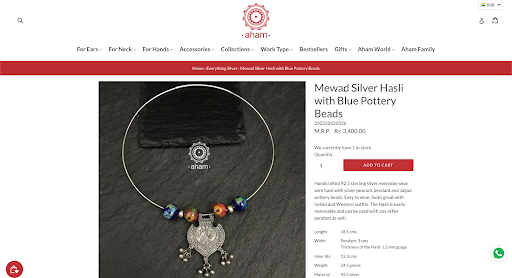
Check out the Shopify store Aham Jewellery that sells products steeped in Indian heritage – for example, Mewad Silver Hasli seen in the image above. Their search engine optimised product page and store help them rank in the top two results for the search term “Mewad Silver Hasli” as seen below.
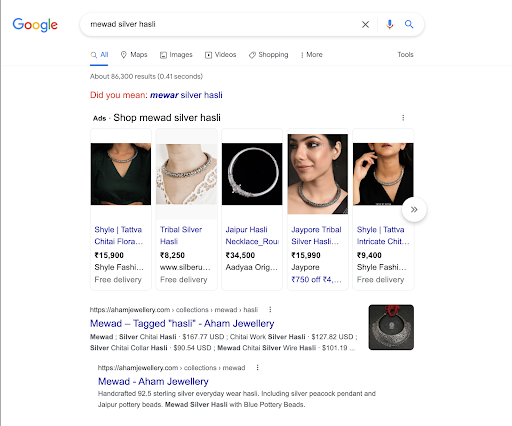
The resources listed below will help you understand search engine optimisation in greater detail.
Additional Resources:
-
CRO (Conversion Rate Optimisation)
Conversion rate optimisation can be defined as focusing on understanding the motivations, likes and dislikes of your users, which allows you to offer them the best possible experience on your store. This, in turn, helps improve your conversion rate. In other words, it is the process of guiding your users to perform “desired actions” using “call to actions” (add to cart, purchase now, check out) on your website. Conversion rate optimisation is very important in the jewellery domain because as said before, jewellery is more often than not an impulse purchase. The better you can guide the user to view, select, and purchase your products, the better sales you will see. This also helps in retaining repeat customers.
Additional Resources:
-
Marketing automation tools
While marketing campaigns can be useful for specific promotions or advertisements, marketing automation helps you grow your customer base and online sales on an ongoing basis. For example, sending automated emails to your customers to recover their abandoned carts requires you to set up your automation system just once.
The same can be done to upsell, reactivate, resell with offers, engage with newsletters and more. For jewellery, in particular, there is usually an uptick in sales around special occasions like birthdays and anniversaries. Automated emails with special offers around such occasions add a personalised touch and are more than likely to drive sales - on autopilot, to boot.
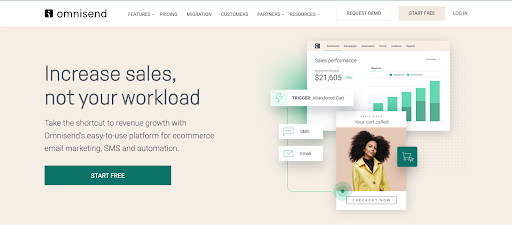
Source: Omnisend
Popular marketing automation tools like Omnisend can be plugged into your Shopify store with just a few clicks.
Additional Resources:
-
Other ecommerce marketing strategies
There are several ecommerce strategies that can be easily adapted to selling jewellery online with a few relevant tweaks. Check out the resources listed below.
Additional Resources:
- Ecommerce Marketing Strategies: A Comprehensive Guide for Growth
- Ecommerce Marketing Essentials: 17 Actionable Tactics to Drive More Sales
- How to Use Newsletters for Marketing?
- Sell on Instagram: Optimise Instagram bio, hashtags and posts to increase sales
- Find The Best Fit: Your Beginner's Guide to Influencer Marketing
- 20 Highly Effective Ways to Promote a Product
- Discounts & Coupons: 19 Ways to Use Deals to Drive Revenue
The steps mentioned in this section should help you get started with selling jewellery online. And further, you will learn as you grow your business by responding to challenges from market trends to competition and more.
-
7. Examples of Indian online jewellery stores
-
Tanishq Store
This is a great example of a leading offline retailer adopting an online sales strategy. Tanishq is an established brand with many retail stores, however considering the growth of online sales, the brand has augmented their sales with an online store.
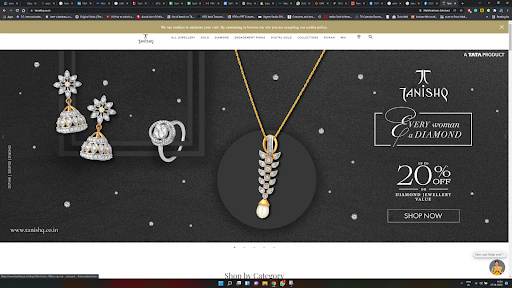
While it’s easy to select a ring that fits your finger in a physical jewellery store, Tanishq overcomes this issue on its online store with a ring-size calculator that estimates the perfect fit for your finger with a QR-code-activated app.
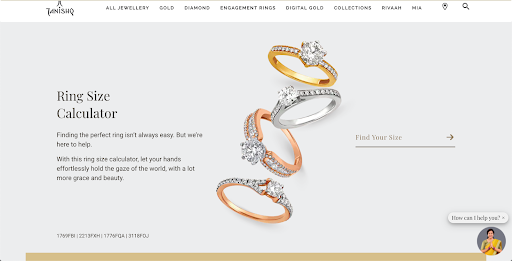
-
Swashaa
Swashaa is an online-only store, powered by Shopify. They focus on the gifting aspect of jewellery in particular, with products that are not very expensive. This is a great example of using Shopify to create an online jewellery store.

Swashaa’s Evil Eye range of necklaces and bracelets targets a trending niche keeping in mind the traditionally held Indian belief of ‘buri nazar’.
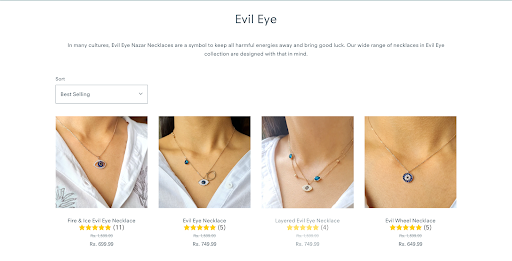
-
Myrha by Rhea Bothra

Myrha is a modern-day jewellery brand “handcrafted with love by the finest artisans of Jaipur”. It has an extremely popular Instagram handle as well as an online Shopify store. Apart from the stunning product photography and attractive storefront, the online store urges visitors to sign up for their mailing lists for updates on new arrivals and insider discounts – making powerful use of the storefront features of Shopify.
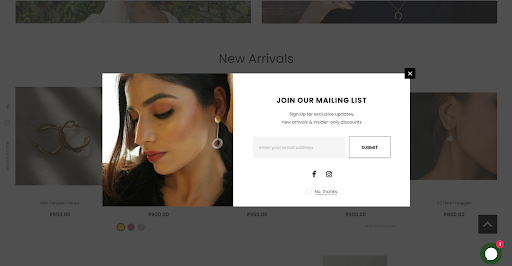
Further reading for Inspiration:
8. Not just a great opportunity, but a golden one
Jewellery is as timeless as history itself. It occupies a special place in the human psyche, and will always have a certain demand. It makes sense to keep up with the times and bring this domain into the future with digital platforms and sales. Be it your hobby or profession, with ecommerce, selling jewellery online can be a profitable alternative business or a lucrative main business.
FAQs
1. Is it profitable to sell jewellery online?
Yes indeed! The market prices of jewellery exceeds the production costs by a significant margin because the value of jewellery goes beyond mere utility. Which means that this is also a high profit-margin business.The online jewellery market in India is projected to be worth USD 2 billion (nearly INR 15,000 crore) by 2022. The annual sales of imitation jewellery online in India are worth around INR 150 to 180 crore.
2. How do I start my own jewellery line online?
To start your own jewellery line, as in a particular style, theme, or collection of jewellery under your own brand name, you need to take the following steps:
- Research the market
- Choose your niche
- Prepare a business plan
- Develop a distinct brand
- Design your website
- Showcase your products
- Add a payment gateway
- Set up the logistics
- Market your products
3. How do I buy jewellery wholesale?
You can rely on various online jewellery wholesalers like Voylla or aggregators like CheapNBest, or you can research and visit offline wholesalers near you.
4. What is private label jewellery?
Private label jewellery is made by a jewellery manufacturer to be sold under the name of a partner business. It is a method to sell jewellery without actually investing in the infrastructure to manufacture it.
5. Are there any registrations/licences required for selling jewellery online in India?
There are a few steps that must be completed to be able to sell jewellery online in India, such as obtaining an establishment licence, GST certificate, and BIS licence, carrying out tax registration, and opening a current account. For more details, there are many resources online that will help you in this regard.
6. What is the best website to sell used jewellery?
Used jewellery can be sold online on Etsy, Amazon or even your own online store. There are several advantages to selling online on your own store including that you don’t have to pay any marketplace commissions for refurbishment or sale.





